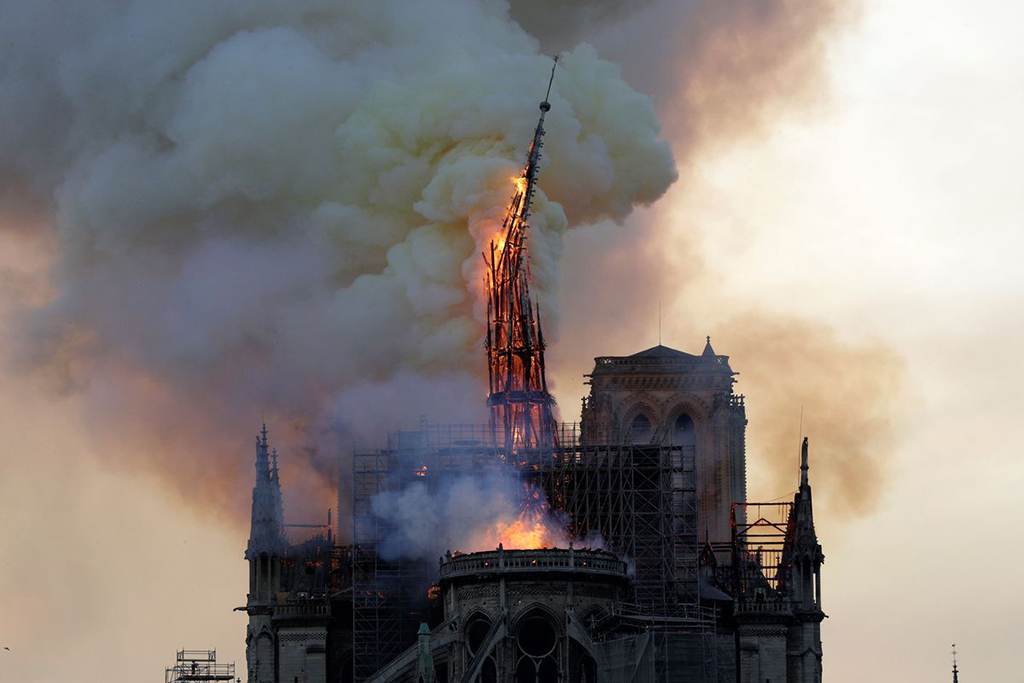What Integrators Can Learn from the Notre-Dame de Paris Cathedral Fire

A sole reliance on onsite monitoring was a key factor in the improper response to the alarms at the Notre-Dame de Paris cathedral, allowing the fire time to spread and cause irreversible damage to the historic structure. Father-daughter pair Tim and Courtney Creenan, a fire safety business owner and architect respectively, share their perspectives of what went wrong and opine how similar catastrophes might be avoided with proper preparation.
On April 15, a fire of still unknown origin burned the famed latticework attic of the Notre-Dame de Paris cathedral to the ground.
Despite the cathedral having a fully-functional aspirating smoke detection system in place, the fire burned unnoticed by guards for 30 minutes before they called the fire department, and best estimates put the time required for firefighters to reach the fire at an additional 20 minutes.
According to reporters, when the system first alerted guards, one of them went to check the attic but did not see any obvious fire. The guard gave the all-clear and the team went about their business, until about 20 minutes later when they saw the growing blaze. They alerted the fire department, but it was too late.
Just a few hours later, the cathedral’s attic and iconic spire were a pile of ashes on the floor of the cathedral.
A Monitoring Mishap
Experts agree it is less likely the fire reaching infernal levels could be blamed on the detection system used at the cathedral and was more likely a result of the response plans in place.
Even with a flawless response to the initial alarm, the size and layout of the building would have meant a lengthy climb for firefighters to the attic. This made it crucial to have the least amount of time possible between the sounding of the alarm and the notification of the fire department, especially for a structure made of such fast-burning material.
“I was surprised to learn that the fire alarm system that was there was not being monitored offsite … You could imagine that an aspirating detection system like what was in the cathedral has a much faster response time, meaning earlier detection,” says Tim Creenan, owner and CEO of ESA member company Amherst Alarm in New York. “So they had probably the best type of system they could get for the detection, and then it all fell apart when they didn’t get the proper response.”
In France, fire alarms never automatically alert the fire department – a fact confirmed to reporters by the Paris Fire Brigade. Due to concerns about false alarms, there must be a “removal of doubt” check by someone on the premises before the fire department is alerted.
For this reason, shifts of two guards were onsite 24/7 at the cathedral to monitor the roof structure and went up three times a day to check the smoke and heat sensors. On the day of the fire, the employee tasked with interpreting the fire alarm panel was working a double shift after his replacement didn’t show. The man had only been working the job for three days when he saw the fateful alert, so he did not understand the importance of verifying which sensor had activated the alarm and for what reason.
“There are really three legs that a system stands on: the proper design and installation – which I think was there – testing and inspection of the system on a frequent basis to make sure that it’s going to work properly and then the third leg is the response,” says Creenan. “That third leg is what broke and fell apart here in several ways. The system wasn’t being monitored offsite, they were depending on a … person working there who didn’t have enough experience and/or training to decipher the information properly and actually sent a security guard to the wrong part of the building, which further delayed the response. And by the time all that was figured out … you had a fully engulfed fire happening, which made it difficult for the fire department.”
Lessons Learned from Loss
The linchpin of the plan to protect the cathedral from fire was an inexperienced guard; however, one person cannot carry the blame for this fire, nor should they have to. With offsite monitoring, more stringent training and more clear readouts from the system for security agents, the fire might have been identified more quickly and guards or a monitoring station could have alerted firefighters sooner, potentially extinguishing the flames before they grew out of control.
“The main takeaway about why this happened is the improper response. There's a well-designed system there that detected the fire, but they didn't get the proper response,” says Creenan.
“If the proper response had been happening – first, that the fire department was called immediately, and second, that then they went to the right part of the building where the fire actually was – then the damage probably would have been much, much less.”
Creenan believes the conservative approach taken by designers in the attic could have remained unobtrusive while still providing proper detection; his team at Amherst Alarm had to work around similar obstacles for a church in Buffalo, New York that had timbers from the 1800s in its attic.
“Having enough heat detectors up there and identifying each heat detector individually so they know if it’s the north end, the south end, or somewhere in the middle lets them know where the fire is originating at,” says Creenan. “It’s also important to make sure that the information that’s displayed on site for occupants and the fire department clearly identifies where the fire is located. We tied that in with monitoring at our UL listed central station so that when an alarm takes place, we get a signal telling us which detector has caused the alarm. When we dispatch the fire department, we can give them the best information and quickest response, so they know exactly where to go when they arrive onsite.”
Moving Forward
In the future, property owners with historic buildings to protect might have reasonable concerns about how their fire systems are installed and whether they are adequate. It is the duty of integrators to have learned from the Notre-Dame de Paris fire, and it might be wise to prepare a way of reassuring potential customers that a similar event would be less likely with proper response procedures in place.
“We would talk [to the concerned customer] about what went wrong there, and here’s how we would prevent those things from going wrong at their site. A big majority of that has to do with monitoring and getting the fire department dispatched as quickly as possible,” says Creenan.
According to Courtney Creenan-Chorley, AIA, project architect at CJS Architects, protecting these buildings is of great cultural importance.
“There is the reason to provide protections from a heritage point of view: once we lose a historic building, they are rarely the same being recreated,” says Creenan-Chorley. “There is reason to protect them from a sustainability point of view: existing buildings have so much inherent energy in them that to protect and to reuse them has less of a carbon footprint than tearing down and starting anew.”
Creenan-Chorley, daughter of Tim Creenan, says that a close collaboration between integrators, architects and owners of historic structures is important for more effective systems.
“Fire protection systems need to be understandable by the people who are going to use them every day. The training of those individuals is equally as important,” says Creenan-Chorley. “Owners of historic structures should carefully assess their situation and determine what level of protection makes the most sense while working to bring their historic building as close to modern standards as possible.”
There are possible improvements all the way from product design to monitoring that could benefit these historic buildings with such great cultural significance, according to Creenan-Chorley.
“A close collaboration during the design process is always key. Many times in historic buildings there are existing finishes and significant character defining features that cannot be impacted visually by new building systems,” says Creenan-Chorley. “More important is for suppliers and installers to be as educated about a building’s significance and why the fire protection system is designed the way it is. If everyone is on board for how to conceal the fire protection that respects the historic character of the building, things go quite smoothly. The design of devices can always be improved from an architect’s point of view.”




